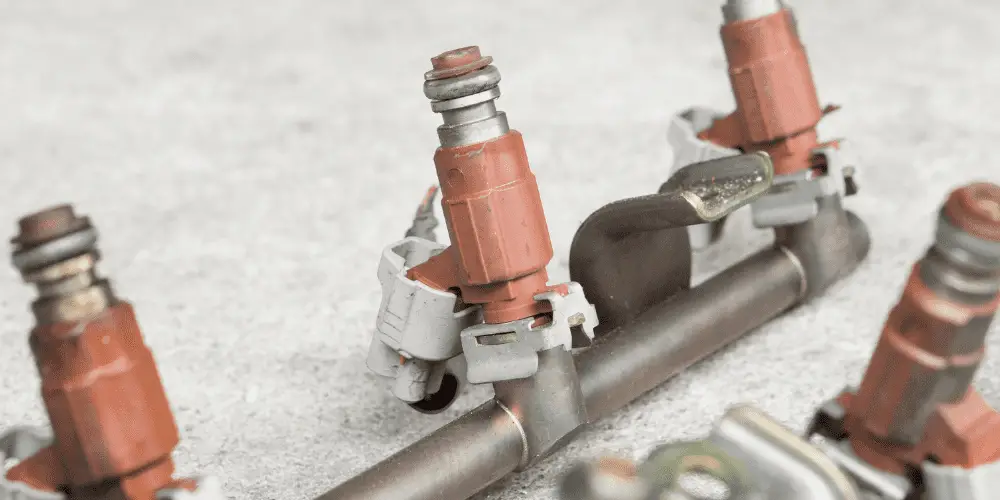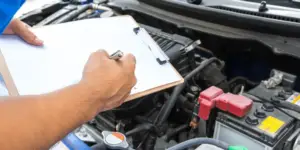A car that runs rich uses more gas and can feel erratic under acceleration and sluggish.
Here we’ll look at the six causes in more detail, along with the fixes and the costs of putting them right.
Running rich relates to a problem with fuel combustion in your engine. Your engine is getting too much gasoline is the root of the problem. On the other hand, when your vehicle is running lean, it has too much oxygen but not enough gas.
Before we get into the details, the reasons are listed below
- Air Filter Clogged
- Mass Airflow Sensor (MAF) Gone Bad
- Fuel Injector(s) Faulty and Spark plugs
- Oxygen Sensor (O2) Exhaust Defective
- Coolant Temperature Sensor Faulty
- Manifold Absolute Pressure (MAP)
1. Clogged Air Filter
The engine’s air filter prevents dust, insects, and other debris from reaching its cylinders.
Over time, the air filter gets clogged and limits the amount of clean air flowing into the engine. Your engine needs air to create power and torque. Without adequate air, your car’s performance will reduce.
This causes an imbalance in the delicate air-fuel ratio, and the lack of air in the engine will cause the engine to run richer.

If a badly clogged air filter can break and allow unfiltered air to move into your engine, all the debris will damage the injectors and sensors.
This might lead to oil leaks, poor compressions, or even oil burning.
Solution
Pop up the hood of your car and locate the air filter – it’s normally in a square, rectangular box. Remove its cover to gain access and take it out of the box.
Pour water on the air filter to remove dust and debris, and suck out the remaining dust using a vacuum cleaner.
Some air filters are one-use, while the more expensive ones are reusable. Even a one-use filter can be cleaned out but may not do a good job the second tind.
Cost to fix
Prepare to pay around $20 to $85 for an air filter replacement. If you intend on keeping the car long-term, invest in a good-quality washable one. It’ll protect your engine better and save money.
2. Faulty Fuel Injector or Spark Plugs
Fuel injectors are located inside your car’s engine. Their job is to regulate the rate and amount of fuel flowing into the combustion chamber inside the engine.
When the fuel injector is stuck open more fuel will flow into the combustion chamber, causing the undesired fuel-air ratio that makes your car run rich.

This will lead to poor engine performance and other tell-tale signs such as engine knocking, car stalling or not starting, poor fuel economy, and the engine management light staying on.
Spark plugs provide a spark that ignites the fuel. They can become full of carbon which results in fewer sparks but too much fuel. This causes a lean running engine.
Solution
Fuel injectors can be cleaned if they aren’t too clogged up. This is the best outcome as it’s the cheapest. If that doesn’t work, you may have to replace them.
Cars have one injector per cylinder and sit within the engine.
A confident DIY mechanic could do this job – as long as they have a comprehensive tool kit – but most people will pay a mechanic to do the job.
Spark plugs can be cleaned but often if one fails the others are close to failing too. It’s usually best to replace them when they start to fail.
Cost to fix
A fuel injector cleaner can cost between $10 and $30. Expect to pay around $800 to $1450 for a full fuel injector replacement.
Spark plugs are cheap in comparison and can be fitted by a DIY mechanic with basic tools.
3. Defective Mass Air Flow (MAF) Sensor
The MAF sensor measures the quantity of air entering the engine and then computes the required air-fuel mixture. It sits between the air intake manifold and the air filter.
When the MAF sensor is dirty or damaged, wrong readings are sent to the car’s ECU.

Other signs of a bad MAF are a lack of power, stalling, no start, and weak acceleration. In some cases, your check engine light also comes on.
Solution
If you have a modern car, a scan tool can measure the amount of mass airflow at various revolutions per minute (RPM.) and therefore show you if your car is running rich.
These scan tools compare your car’s output against the confirmed manufacturer’s settings stored in the tool.
A faulty MAF sensor will show a lower reading than a known good one. But in other rare cases, a defective sensor will show higher readings, resulting in an engine running lean – getting too much air.
A very handy tool we have mentioned many times is an OBD reader. This device reads the faults that are stored in your car’s computer. Cheap to buy and will save you time and money over the lifetime of your car.
The fault code for a bad MAF sensor is P0102.
MAFs can often be cleaned rather than replaced, and this video gives a detailed walkthrough of how to do it.
Cost to fix
Replacing your MAF costs between $240 to $330, including labor and parts.
A cleaning spray can cost $10 to $15, so it’s always worth attempting a clean first.
4. Faulty Oxygen(O2) Sensors
The exhaust pipe is fitted with oxygen sensors to detect the air-fuel mixture as the gases leave the engine.
The O2 sensors inform the engine control unit to increase the amount of fuel in the subsequent combustion (if it detects a lean mixture in the previous combustion) and vice versa.
A damaged oxygen sensor can erroneously tell the engine to add more fuel despite having the proper air-fuel ratio. This results in the engine having a rich fuel mixture and the other symptoms mentioned above.
You will start experiencing poor fuel efficiency, and your car may fail an emissions test.
Solution
Link an OBD reader to your car’s ECU; you’re looking for either code P0420, P0141, or P0135.

Even seeing these indicates that the sensor may be faulty but doesn’t confirm it.
Removing the O2 sensor and cleaning it by soaking it in gasoline often works, although if the problem persists, you’ll have to replace it.
Cost to fix
A new O2 sensor ranges from $20 to $100, depending on your car model. A mechanic will charge around $200 to get the problem fixed. This includes the part and labor.
5. Faulty Manifold Absolute Pressure (MAP)
Unlike the MAF sensor, the MAP sensor calculates air density in the intake manifold to establish the airflow index.
You can find it on the throttle body on the intake manifold. It’s a sensitive part and can get clogged, contaminated, or damaged by the engine’s heat.
When the MAP sensor is damaged, it cannot accurately calculate the air mixture. This leads to a skewed air-fuel ratio.
Solution
Often they can be cleaned with a spray can of electrical cleaner.
If you discover that it’s damaged – perhaps from engine heat – it’s a case of replacing the part.
Cost to fix
A replacement MAF costs between $130 and $380, depending on the make and model of your car. This includes labor costs. It’s a job that most DIY mechanics should be able to do without too much difficulty.
6. Defective Engine Coolant Temperature Sensor
A cold engine requires more fuel to operate properly.
The engine coolant temperature sensor calculates the temperature of the coolant to determine when to add extra fuel to the engine.
If this sensor is faulty, it may result in a rich mixture.
Solution
When the check engine light comes on, get a professional with a diagnostic scan tool to identify the problem. Or buy one here.
Also, some manufacturers recommend replacing the engine coolant temperature sensor at 100000 miles, although most recommend replacing it as required.
Besides poor fuel efficiency and other problems discussed above, your car may also experience overheating.
Cost to fix
The price of fixing a damaged coolant temperature sensor is between $95 and $140.
This will depend on the model and year of your car and your mechanics’ fees.
In Conclusion
A car that runs rich is because of an imbalance in the air-to-fuel mix in the engine. This isn’t a problem, but it can cause other parts to fail, which can affect your car engine from overheating or cause your engine to become affected by a carbon build-up.
The best place to check first is the air filter. After this, invest in an OBD reader to narrow down the offending part first rather than start guessing and removing sensors through guesswork. It’ll save you hours.
Another benefit of knowing the car’s fault before taking it to a car shop for repair is you’ll be better informed before you drop your car off.













